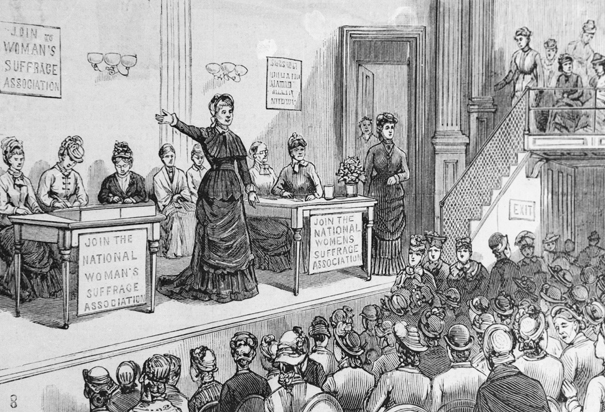|
Moderated by NW Okie! |
Volume 14 , Issue 102012Weekly eZine: (366 subscribers)Subscribe | Unsubscribe Using Desktop... |
Women's Suffrage History In America

This week's OkieLegacy Ezine celebrates our ancestors who fought for "Women's Rights" going back to when it began at the National Women's Suffrage Association in Chicago in 1880. If only we could go back while our grandmother's were still alive to ask them their thoughts on the Women's Suffrage movement in America! Did they participate or following with an intense and passionate feeling for "Rights of All Women and human beings?"
The first women's rights convention took place in Seneca Falls, N.Y., in July 1848. The declaration that emerged was modeled after the Declaration of Independence. Written by Elizabeth Cady Stanton. It claimed that "All men and women are created equal" -- "The history of mankind is a history of repeated injuries and usurpations on the part of man toward woman." Following a long list of grievances were resolutions for equitable laws, equal educational and job opportunities, and the right to vote.
It was a group of middle-class, mixed with professional women, who revived organized suffrage activity in the mid-1880's when they founded the Cook County Suffrage Association. In 1890's the Chicago area movement gained significant momentum when the rift in the National Suffrage movement was healing over whether to seek National or state-by-state suffrage.
In 1901, Catharine Waugh McCulloch led a small movement to secure women taxpayers' right to elect township officials who assessed and collected taxes. This was a time when Suffragist women expanded their focus in scurrying municipal suffrage for all women to protect their homes and families in the city. In 1906, the Suffragists seized upon Chicago's attempt to write a new municipal charter to demand that any new charter legislation include municipal suffrage for all women. The charter failed to include municipal suffrage. A hundred women's organizations, which included working-class and immigrant women, waged a successful campaign to urge male voters to defeat the charter when it was put before Chicago voters in late 1907. It was in 1910 when many of the most active suffragists organized their own Suffragist Party.
The movement crossed class, race and ethnic boundaries. According to Encyclopedia Chicago History. "Restaurant worker Elizabeth Maloney led the Self-Supporting Women's Equal Suffrage Association. Glove-worker, Agnes Nestor, journeyed to Springfield in 1909 to lobby for suffrage, along with the leader of the Jewish Chicago Woman's Aid, Flora Witkowsky. Women's clubs of the city's settlement houses distributed suffrage leaflets and sold buttons declaring "Votes for Women" on one side and "Women's Trade Union League" on the other side. When the Socialist Party held its national convention in Chicago in 1908, Chicagoan Corinne Brown led socialist women in organizing a separate meeting to establish women's organizations to pursue suffrage.
In 1913, Ida B. Wells-Barnett organized the Alpha Suffrage Club of African American Women. Chicagoan Mary Fitzbutler Waring was a leading African American campaigner for woman suffrage, while Chicagoan Mary C. Bryon was named one of the few African American organizers in the National American Woman Suffrage Association. Thousands of working women joined the Wage Earners' Suffrage League organized by Emma Steghagen.
It was not until 1913 when the Illinois legislature gave all women of the state suffrage for local and national elections. BUT . . . Because women's citizenship was tied to her husband's citizenship by a National Law of 1907, many women could NOT vote. More than 150,000 Chicago women registered to vote in the Spring of 1914. The campaign continued because many of the Chicago area women remained unwilling to settle or anything short of full political equality. Only full suffrage came with the National Amendment in 1920 with Chicago playing its final role in the Women's Suffrage Movement. The National American Woman Suffrage Association was disbanded and replaced with the "League of Women Voters.
Below is a small list of some of the Suffrage and the Women behind it as it dates back to the Session of National Woman's Suffrage Association in Chicago, 1880. The campaign for women's suffrage began in the decades before the Civil War, though. It gained momentum in the 1850's, led by abolitionist activists such as Lucy Stone, Susan B. Anthony, Elizabeth Cady Stanton and Alice Paul.
- Lucy Stone: Born in 1818, Lucy Stone lectured for the American Anti-Slavery Society and founded the weekly feminist newspaper The Woman's Journal. She is known for her refusal to change her last name when she married fellow abolitionist Henry Blackwell.
- Susan B. Anthony in December 1898: Perhaps the most well-known women's rights activist in American history, Susan B. Anthony was born in 1820 and raised as a Quaker. She dedicated her life to numerous causes, including universal suffrage, women's property rights, the abolition of slavery and temperance.
- Elizabeth Cady Stanton: Along with the abolitionist and temperance activist Lucretia Mott, Elizabeth Cady Stanton organized the first women's rights convention, which took place in 1848 in Seneca Falls, New York. She served as the first president of the National American Woman Suffrage Association.
- Alice Paul Toasting Tennessee's Ratification of the 19th Amendment, August 1920: The leader of the suffrage movement's most militant wing, Alice Paul advocated "unladylike" tactics such as civil disobedience and hunger strikes. In 1920, she proposed an Equal Rights Amendment to the Constitution, which has never been ratified.
- Suffragist Parade in New York City, May 1912: Women's rights activists continued their efforts throughout the first two decades of the 20th century. While World War I slowed the suffragists' campaign, war efforts by women ultimately helped them advance their argument.
- Suffragettes Celebrate the Passing of the 19th Amendment: On August 26, 1920, the 19th Amendment to the Constitution was finally ratified, granting American women the right to vote.
| © . Linda Mcgill Wagner - began © 1999 Contact Me | |
